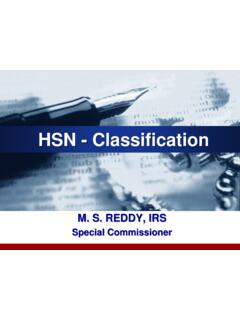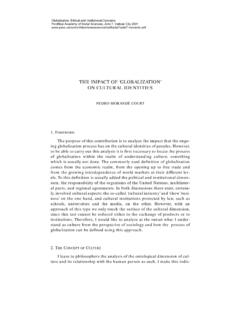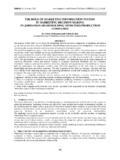Transcription of SARATH & ASSOCIATES Chartered Accountants info@sarathcas
1 Fundamentals of AccountingSARATH & ASSOCIATESC hartered 4322/7090 Glimpse of the Session Definition Systems of Accounting Functions of Accounting Basis of Accounting Classification of Accounts Golden Rules of Accounting Examples Books of Accounts Manual Vs Software Financial Statements --Meaning and contents ReportingAccounting Definition Recording Classifying Summarizing Analyzing Interpreting CommunicatingTransactions & Events in Monetary TermsExamples of Events/TransactionsoReceived Loan from Uncle of ,00,000 through ChequeoOpened Bank Account & deposited ChequeoPurchased Land for ,00,000oGiven Advance for purchase of GodownBuilding ,000oBought a Motorcycle for loan to friend ,00,000oStarted small business by investing for Tables/ Chairs/FurnitureoPurchased Goods for ,00,000oSold 80% of those Goods for ,20,000oFriend repaid ,000 out of loan given by you within 1 month oPaid Income Tax on Profit made during periodoReceived Advance amount of ,000 from Customers to whom you promised to supply after 1 monthRecording Process in which the financial transactions and events that are identified are recorded in Books These typically would be Cash Book/ Bank Book Purchase and Sales Books Bills Receivable and Bills Payable Books Purchase and Sales Return Books Journal Book (other than above)Classifying Process where transactions or entries of one or similar nature are grouped.
2 The book containing classified information is called Ledger . For Example, there may be separate account heads for Sales, Purchases, GST, Salaries, Rent, Office Expenses, Taxes Paid, Advertisement expenditure etc.,Summarizing Involves preparation and presentation of the Classified Data in a manner useful to various internal and external users. Leads to the preparation of the following financial statements oTrial BalanceoProfit and Loss AccountoBalance SheetoCash-Flow StatementAnalysis & Interpretation Includesanalyzingandtheninterpretingthef inancialdatatomakeameaningfuljudgementof theprofitabilityandfinancialpositionofth ebusiness. The financial statement should explain not only what had happened but also why it happened and also what is likely to happen under specified conditions Communicating It is concerned with the transmission of analyzed and interpreted information to the end-users to enable them to make rational decisions This includes preparation and distribution of accounting statements/Annual Reports Users of Financial informationINTERNAL USERS Board of Directors Partners Managers Officers EmployeesEXTERNAL USERS Investors Lenders Suppliers Government CustomersFunctions of AccountingMeasurementMeasures past performance of the business entity and depicts its current financial positionForecastingHelps in forecasting future performance and financial position of the enterprise using past dataDecision-makingProvides
3 Relevant information to the users of accounts to aid rational decision makingComparison & EvaluationAssesses performance achieved in relation to targets which is important for predicting, comparing and evaluating the financial resultsControlDefines weaknesses of the operational system and provides feedbacks regarding effectiveness of measures adopted to check such weaknessesGovt. Regulation & TaxationProvides necessary information to the government to exercise control on the entity as well as in collection of tax revenuesBasis of AccountingCash BasisAccrual BasisComparison of MethodsCASH BASIS Recognizes revenues when cash is received and expenses when they are paid. Does not recognize accounts receivable or accounts payable Beneficial in terms of tracking how much cash the business actually has at any given time Since the transactions are not recorded until the cash is received or paid, the business s income is not taxed until it is in the bankACCRUAL BASIS Revenues and expenses are recorded when the are earned or Due, regardless of when the money is actually is received or paid Gives a more realistic idea of income and expenses during a period of time, therefore providing a long term picture of the business that cash accounting can t provide Most widely followed method, mandatory for Companies etc.
4 ,DOUBLE ENTRY SYSTEM OF BOOK KEEPING This is the system of Keeping the Books of Accounts world wide and now India is also following the same It is based on the principle that every business transaction has two accounts in opposite directions and if a complete record is to be made of each such transaction, it would be necessary to Debit one account and Credit one Account. So every Debit has corresponding Credit and every Credit has corresponding Debit with equal amount Classification of AccountsPersonalRealNominalPersonal Accounts Natural personal accounts:The elements or accounts which represent s A/c, Asha A/c etc. Artificialpersonal accounts:Personal accounts which are created artificially bylaw, suchas corporate bodies andinstitutions, are called Artificial personal Ltd Companies, LLPs, Clubs, Societies/Schoolsetc.
5 Representative personal accounts:Accounts which represent a certain person or a group directly or expense a/c, Prepaid expense a/cGolden Rule for Personal Accounts Debit the ReceiverCredit the GiverExample : Paid M/s Mitra Agencies ,000 by ChequeAccounts Involved Mitra Agencies A/c To Bank a/cDebit/Credit Debit CreditRule Applied Personal a/c-Debit the Receiver Personal a/c-Credit the GiverReal Accounts All assets of a firm, which are tangible or intangible, fall under the category Real Accounts . Tangible real accountsare related to things that can be touched and felt physically. Few examples of tangible real accounts are Building, Machinery, Stock, Land etc. Intangible real accountsare related to things thatcan t betouched and felt physically. Few examples of such real accounts are Goodwill, Patents (new Invention), Trademarks (Brand Name such as Chutneys, Chermas, Bata, Titan etc.)
6 Golden Rule for Real Accounts Debit what comes inCredit what goes outExample :Purchased Furniture for ,000 in cashAccounts Involved Furniture a/c To Cash a/cDebit/Credit Debit CreditRule Applied Real a/c-Debit what comes in Real a/c-Credit what goes outNominal Accounts Accounts whichare relatedto expenses, losses, incomes or gains are called Nominal accounts. Nominal accounts do not really exist in physical form, but behind every nominal account money is involved. A/c, Salary A/c, Sales A/c, Commission paid A/c, Commissionreceived A/c The final result of all nominal accounts is either profit or loss which is then transferred to the capital Rule for Nominal Accounts Debit all expenses and lossesCredit all incomes and gainsExample : Paid Salaries of ,000 in cashAccounts Involved Salaries a/c To Cash a/cDebit/Credit Debit CreditRule Applied Nominal a/c-Debit all expenses Real a/c-Credit what goes outBasic Accounting RulesIncomeExpenditure Liability Asset Debit Credit25 Rules of Accounting Type of Account Debit CreditPersonal The Receiver The GiverReal What Comes InWhat goes out Nominal All Expenses & LossesAll Incomes & Gains 26 Flow of Accounting Understanding the Transaction VoucherEntry Posting BalancingTrial BalanceP & L AccountBalance Sheet27 Financial StatementsFinancial Statements are Summary-level reports about an organization's financial results, financial position and cash flows.
7 Useful for: Determine the ability of a business to generate cash, and the sources and uses of that cash. Determine whether a business has the capability to pay back its debts. Track financial results on a trend line to spot any profitability issues. Investigate the details of certain business transactionsStandard contents of a set of financial statements: Balance Sheet: Shows the entity's assets, liabilities, and shareholders' equity as of the report date. Income Statement: Shows the results of the entity's operations and financial activities for the reporting period. It includes revenues, expenses, gains, and losses. Statement of Cash Flows: Shows changes in the entity's cash flows during the reporting period. Supplementary Notes: Includes explanations of various activities, additional detail on some accounts, and other items as mandated by the applicable accounting framework, worldwideStructure of Accounting Ledger AccountsIncome CreditDebitLiability AssetExpenditure Balance Sheet P & L Account30 Ledger Grouping Income GroupsLiability GroupExpenditure Groups Asset Group31 Profit and Loss Account(P&L) Financial statement that summarizes the revenues, costs, and expenses incurred during a specified period, usually a year or even Quarterly (for Stock Exchange Listed Companies).
8 This Statement provide information about a company's abilityor inabilityto generate profit by increasing revenue, reducing costs, or both. P&L Management refers to how a company handles its Profit or Loss through revenue and cost management, by taking suitable & Loss Account GroupIncomeDirect Income Indirect Income Sales Accounts ExpenditureDirect ExpensesIndirect ExpensesPurchase Accounts 33 Balance Sheet A balance sheet is a financial statement that reports a company's assets, liabilities and shareholders' equity at a specific point in time, and provides a basis for computing rates of return and evaluating itscapital structure. It is a financial statement that provides a snapshot of what a company owns and owes, as well as the amount invested by Sheet Group Liabilities : CapitalReserves & SurplusLoans (Liability) Secured Loans Unsecured LoansCurrent Liabilities Bank OCC/Bank OD Provisions Sundry Creditors Assets.
9 Fixed AssetsInvestmentsCurrent Assets Bank Accounts Cash in Hand Sundry Debtors Deposit (Assets) Loans & Advances (Asset)35 Computerization of Accounts Like all functions which are being automated now, Accounting is also automated through Computerization & Specific Accounting Softwares Computerized Accounting System is Accounting Information System which processes financial transactions and events as per Generally Accepted Accounting Principles (which we saw earlier) to produce Reports as per User Requirement Based on the size of organization, there may be Single User software or there may be a Server having Software with number of users Tally and Focus are most widely used Softwaresin India Manual Accounting It is a system of accounting that uses physical account books for keeping financial records.
10 All the calculation is performed manually. Entries are made in Book of Original Entry. The final result is to provide the Financial Statements at the end of the Accounting It is a system of accounting that uses an accounting software for recording financial transactions electronically Only data input is required, the calculations are performed by computer system. Entries are recorded in software like Tally, Focus, Quick Books etc. The final result is to provide Financial Statements at any time given in a Flow Statement Cash Flow Statement summarizes the amount ofcash and cash equivalents entering and leaving a company during a particular period of time The cash flow statement (CFS)measures how well a company generates cash to pay itsdebt obligations and fund itsoperating Report An annual report is a publication that public corporations must provide annually to shareholdersto describe their operations and financial conditions and contains detailed financial and operational information.






